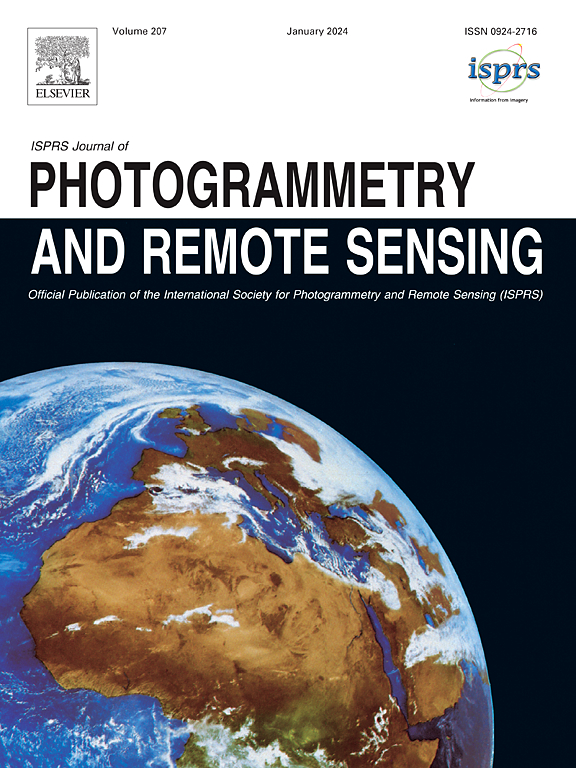Generalization in deep learning-based aircraft classification for SAR imagery
IF 10.6
1区 地球科学
Q1 GEOGRAPHY, PHYSICAL
ISPRS Journal of Photogrammetry and Remote Sensing
Pub Date : 2024-11-08
DOI:10.1016/j.isprsjprs.2024.10.030
引用次数: 0
Abstract
Automatic Target Recognition (ATR) from Synthetic Aperture Radar (SAR) data covers a wide range of applications. SAR ATR helps to detect and track vehicles and other objects, e.g. in disaster relief and surveillance operations. Aircraft classification covers a significant part of this research area, which differs from other SAR-based ATR tasks, such as ship and ground vehicle detection and classification, in that aircrafts are usually a static target, often remaining at the same location and in a given orientation for longer time frames. Today, there is a significant mismatch between the abundance of deep learning-based aircraft classification models and the availability of corresponding datasets. This mismatch has led to models with improved classification performance on specific datasets, but the challenge of generalizing to conditions not present in the training data (which are expected to occur in operational conditions) has not yet been satisfactorily analyzed. This paper aims to evaluate how classification performance and generalization capabilities of deep learning models are influenced by the diversity of the training dataset. Our goal is to understand the model’s competence and the conditions under which it can achieve proficiency in aircraft classification tasks for high-resolution SAR images while demonstrating generalization capabilities when confronted with novel data that include different geographic locations, environmental conditions, and geometric variations. We address this gap by using manually annotated high-resolution SAR data from TerraSAR-X and TanDEM-X and show how the classification performance changes for different application scenarios requiring different training and evaluation setups. We find that, as expected, the type of aircraft plays a crucial role in the classification problem, since it will vary in shape and dimension. However, these aspects are secondary to how the SAR image is acquired, with the acquisition geometry playing the primary role. Therefore, we find that the characteristics of the acquisition are much more relevant for generalization than the complex geometry of the target. We show this for various models selected among the standard classification algorithms.
基于深度学习的合成孔径雷达图像飞机分类中的泛化问题
合成孔径雷达(SAR)数据的自动目标识别(ATR)应用范围广泛。合成孔径雷达自动目标识别(ATR)有助于探测和跟踪飞行器和其他物体,例如在救灾和监视行动中。飞机分类是这一研究领域的重要组成部分,它不同于其他基于合成孔径雷达的 ATR 任务,如船舶和地面车辆的探测和分类,因为飞机通常是静态目标,经常在同一地点和特定方向停留较长时间。如今,基于深度学习的飞机分类模型的丰富程度与相应数据集的可用性之间存在严重不匹配。这种不匹配导致模型在特定数据集上的分类性能有所提高,但对训练数据中不存在的条件(预计会在运行条件下出现)进行泛化的挑战尚未得到令人满意的分析。本文旨在评估深度学习模型的分类性能和泛化能力如何受到训练数据集多样性的影响。我们的目标是了解模型的能力,以及它在什么条件下可以熟练完成高分辨率合成孔径雷达图像的飞机分类任务,同时在面对包括不同地理位置、环境条件和几何变化在内的新数据时展示泛化能力。我们利用 TerraSAR-X 和 TanDEM-X 人工标注的高分辨率合成孔径雷达数据弥补了这一不足,并展示了在需要不同训练和评估设置的不同应用场景下,分类性能的变化情况。我们发现,正如预期的那样,飞机的类型在分类问题中起着至关重要的作用,因为飞机的形状和尺寸会有所不同。然而,这些方面对于如何获取合成孔径雷达图像是次要的,而获取几何图形才是主要的。因此,我们发现获取图像的特征比目标的复杂几何形状更适合进行归纳。我们从标准分类算法中选择了多种模型来说明这一点。
本文章由计算机程序翻译,如有差异,请以英文原文为准。
求助全文
约1分钟内获得全文
求助全文
来源期刊

ISPRS Journal of Photogrammetry and Remote Sensing
工程技术-成像科学与照相技术
CiteScore
21.00
自引率
6.30%
发文量
273
审稿时长
40 days
期刊介绍:
The ISPRS Journal of Photogrammetry and Remote Sensing (P&RS) serves as the official journal of the International Society for Photogrammetry and Remote Sensing (ISPRS). It acts as a platform for scientists and professionals worldwide who are involved in various disciplines that utilize photogrammetry, remote sensing, spatial information systems, computer vision, and related fields. The journal aims to facilitate communication and dissemination of advancements in these disciplines, while also acting as a comprehensive source of reference and archive.
P&RS endeavors to publish high-quality, peer-reviewed research papers that are preferably original and have not been published before. These papers can cover scientific/research, technological development, or application/practical aspects. Additionally, the journal welcomes papers that are based on presentations from ISPRS meetings, as long as they are considered significant contributions to the aforementioned fields.
In particular, P&RS encourages the submission of papers that are of broad scientific interest, showcase innovative applications (especially in emerging fields), have an interdisciplinary focus, discuss topics that have received limited attention in P&RS or related journals, or explore new directions in scientific or professional realms. It is preferred that theoretical papers include practical applications, while papers focusing on systems and applications should include a theoretical background.
 求助内容:
求助内容: 应助结果提醒方式:
应助结果提醒方式:


